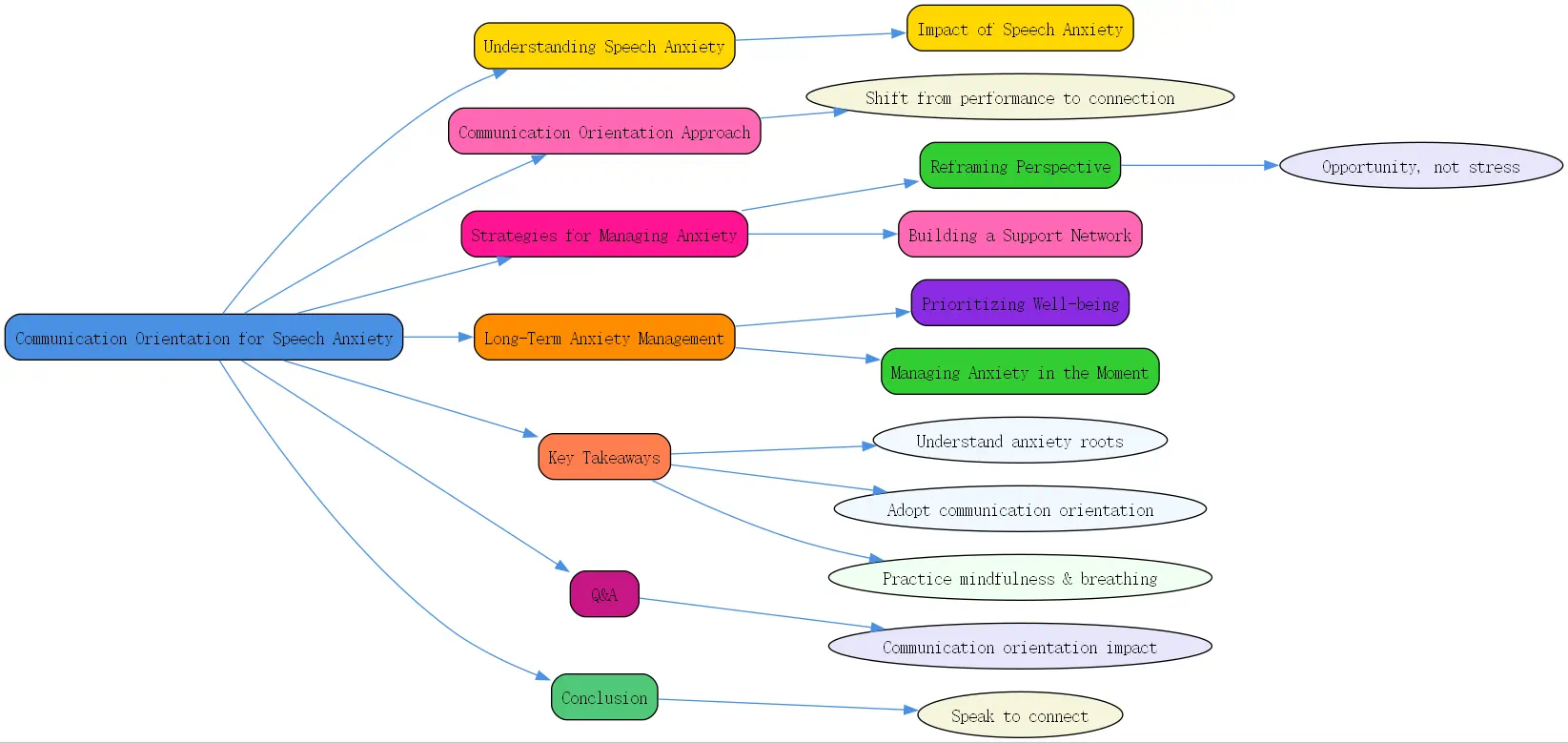Managing Speech Anxiety: The Communication Orientation Approach

Public speaking. For many, these two words alone can trigger a cascade of anxious thoughts and physical discomfort. Palms sweat, hearts race, and voices tremble. This common experience, known as speech anxiety or glossophobia, can significantly impact academic, professional, and personal lives. But what if there was a way to shift your perspective and transform this fear into a more manageable, even positive, experience? At BrainTalking, we believe understanding the root of this anxiety is the first step toward overcoming it.
Often, speech anxiety stems from a performance orientation ??an intense focus on being judged, evaluated, and potentially failing in front of others. This mindset amplifies self-consciousness and the perceived stakes of speaking. However, adopting as a means of managing speech anxiety the communication orientation offers a powerful alternative. This approach reframes public speaking not as a performance, but as an opportunity to connect, share ideas, and engage with an audience.
Understanding Speech Anxiety and its Impact
Defining Speech Anxiety: Identifying the root causes and common symptoms.
Speech anxiety is more than just simple nervousness; it’s a significant fear associated with speaking in front of others. Its roots often lie in negative past experiences, fear of judgment or criticism, perceived lack of skill, or the pressure to perform perfectly. This fear manifests physically (rapid heartbeat, sweating, trembling, nausea), cognitively (negative self-talk, catastrophizing, memory blanks), and emotionally (intense fear, dread, panic). Understanding these symptoms is crucial for identifying and addressing the anxiety effectively.
The anticipation of speaking can be just as debilitating as the act itself. Many individuals spend days or weeks worrying, losing sleep, and avoiding situations that might require public speaking. This avoidance can limit career opportunities, hinder academic participation, and strain social interactions. Recognizing the multifaceted nature of this anxiety helps in developing comprehensive coping mechanisms.
The Communication Orientation: Shifting focus from performance to connection.
The communication orientation fundamentally changes the goal of public speaking. Instead of striving for a flawless performance judged by others, the focus shifts to successfully conveying a message and connecting with the listeners. It’s about sharing information, telling a story, or persuading an audience because you have something valuable or interesting to say. This perspective views the audience not as judges, but as partners in a communicative exchange.
Think of it like having a conversation, albeit with more people. When you talk to a friend, you’re focused on understanding and being understood, not on delivering perfect lines. Applying this conversational mindset to public speaking lessens the pressure. The goal becomes clarity, engagement, and mutual understanding, which are far less intimidating prospects than achieving unattainable perfection under scrutiny. This shift is central to using the communication orientation effectively.
Why a Communication Orientation Reduces Anxiety: Building confidence and reducing self-consciousness.
By focusing on the message and the audience, the communication orientation naturally pulls attention away from the self. When you’re genuinely invested in sharing your ideas and connecting with listeners, there’s less mental space for self-critique and worry about judgment. This external focus significantly reduces the self-consciousness that fuels so much speech anxiety.
Furthermore, this approach builds authentic confidence. Success is redefined not by flawlessness, but by effective communication ??did the audience understand the message? Was there engagement? Achieving these communication goals feels rewarding and reinforces the speaker’s ability to connect, gradually diminishing the fear associated with future speaking engagements. It fosters a sense of purpose beyond just surviving the speech.
Strategies for Managing Speech Anxiety Through Communication
Adopting a communication orientation isn’t just a theoretical shift; it involves practical techniques that help ground you in the moment and manage anxiety symptoms. These `strategies for managing speech anxiety` empower you to take control and focus on connection.
Reframing Your Perspective: From Stress to Opportunity
Mindfulness and Presence: Staying grounded in the moment to reduce anxiety.
Mindfulness, the practice of paying attention to the present moment without judgment, is a cornerstone of anxiety management. As mentioned in general stress reduction resources, staying grounded helps reduce feelings of overwhelm. In the context of speech anxiety, mindfulness helps you detach from racing thoughts about potential failures or audience reactions. Focus on your breath, the feel of your feet on the floor, or the faces of engaged listeners.
Practicing mindfulness regularly, not just before speaking, builds your capacity to stay present under pressure. Techniques like body scanning or simply observing your thoughts without getting carried away can be incredibly helpful. This presence is key for `managing anxiety in the moment`, allowing you to respond authentically rather than reactively to fear. You can find more resources on mindfulness practices on platforms like Mindful.org.
Breathing Techniques for Immediate Relief: Box breathing and the 4-7-8 method.
When anxiety spikes, our breathing often becomes shallow and rapid, signaling panic to the brain. Consciously controlling your breath can counteract this. Deep breathing exercises, as highlighted in stress management guides, are highly effective for calming the nervous system almost instantly. These are invaluable tools for `managing anxiety in the moment`, right before you step up to speak or even during a brief pause.
- Box Breathing: Inhale slowly for 4 seconds, hold for 4 seconds, exhale slowly for 4 seconds, and hold again for 4 seconds. Repeat several cycles. This rhythmic pattern is easy to remember and very grounding.
- 4-7-8 Method: Inhale quietly through your nose for 4 seconds, hold your breath for 7 seconds, and exhale completely through your mouth with a whooshing sound for 8 seconds. This technique, popularized by Dr. Andrew Weil, acts as a natural tranquilizer for the nervous system. Learn more about 4-7-8 breathing here.
Progressive Muscle Relaxation (PMR): Easing physical tension associated with anxiety.
Anxiety often manifests as physical tension ??clenched jaws, tight shoulders, stiff necks. Progressive Muscle Relaxation (PMR) directly addresses this physical component. This technique involves systematically tensing and then releasing different muscle groups throughout the body. By consciously tensing, you become more aware of where you hold tension, and the subsequent release promotes deep physical relaxation.
Start with your toes, tensing them tightly for 5 seconds, then releasing completely for 10-15 seconds, noticing the difference. Work your way up through calves, thighs, abdomen, chest, arms, hands, shoulders, neck, and face. Practicing PMR regularly can reduce baseline tension, making you less susceptible to physical anxiety symptoms when faced with public speaking. It’s a practical step in managing the physical side of speech anxiety.
Building a Supportive Network for Overcoming Speech Anxiety
Overcoming speech anxiety is rarely a solitary journey. Leveraging support systems can provide encouragement, practical help, and perspective, making the process less daunting.
Seeking Help and Sharing Your Fears: Talking to trusted individuals.
Just as discussing school stress can reduce its burden, talking about speech anxiety with trusted friends, family, mentors, or colleagues can be immensely helpful. Sharing your feelings validates your experience and reduces the sense of isolation that anxiety often brings. These individuals can offer empathy, encouragement, and sometimes, practical feedback if you choose to practice with them.
Don’t hesitate to seek professional guidance if speech anxiety significantly impacts your life. Therapists specializing in anxiety disorders or communication coaches can provide tailored strategies, including Cognitive Behavioral Therapy (CBT), which is highly effective for anxiety. Resources like the Anxiety & Depression Association of America (ADAA) offer directories and information. BrainTalking also offers resources connecting users with specialists.
Peer Support and Group Communication: Practicing in supportive environments.
Engaging with peers facing similar challenges can be incredibly beneficial. Joining a public speaking club (like Toastmasters International) or forming an informal practice group provides a safe, supportive environment to hone your skills. Practicing in front of others who understand your anxiety reduces the fear of judgment and allows for constructive feedback.
These groups embody the communication orientation ??the focus is typically on mutual improvement and support, not on harsh critique. Regular practice in such low-stakes settings builds confidence incrementally. It allows you to experiment with delivery, receive feedback on message clarity, and become more comfortable connecting with an audience, reinforcing the positive aspects of communication.
Long-Term Anxiety Management and Preparation
While in-the-moment techniques are crucial, long-term strategies build resilience and reduce the baseline level of anxiety, making speech situations less intimidating over time.
Prioritizing Well-being to Reduce Anxiety
Your overall physical and mental state significantly influences your ability to cope with stressors like public speaking. Consistent self-care isn’t a luxury; it’s foundational for anxiety management.

Time Management: Organizing tasks to reduce feeling overwhelmed.
Poor time management is a major stress contributor, often leading to procrastination and last-minute panic, especially when preparing for a speech. Feeling rushed intensifies anxiety. Implementing effective time management strategies, such as using planners, breaking down preparation into smaller tasks (research, outline, practice), and setting realistic deadlines, can prevent this overwhelm.
Starting preparation early allows ample time for research, structuring your message, and, importantly, practicing delivery. Knowing you are well-prepared significantly boosts confidence and reduces anxiety. This organized approach shifts focus from frantic survival to thoughtful communication, aligning perfectly with the communication orientation. This is also key for `managing stress and anxiety at work`, where presentations are common.
Healthy Lifestyle Choices: Exercise, balanced diet, and adequate sleep.
The mind-body connection is undeniable. Regular physical activity is a potent stress reliever, boosting mood-enhancing endorphins. A balanced diet supports stable energy levels and brain function; conversely, excessive caffeine or sugar can worsen anxiety symptoms. Prioritizing these is essential.

Adequate sleep is perhaps most critical. Lack of sleep impairs cognitive function, emotional regulation, and focus, making anxiety feel much worse. Aiming for 7-9 hours of quality sleep per night provides the mental and emotional resources needed to manage speech anxiety effectively. These lifestyle factors create a buffer against stress, making you better equipped to handle challenging situations like public speaking.
Practical Tips for Managing Anxiety in the Moment
Beyond foundational strategies, specific techniques applied just before or during a speech can make a significant difference. These tools help maintain composure and focus when anxiety threatens to derail your communication efforts.
Visualization Techniques: Mental rehearsal for a successful presentation.
Visualization, or mental rehearsal, involves vividly imagining yourself successfully delivering your speech. Picture yourself standing confidently, speaking clearly, connecting with the audience, and feeling calm and composed. Focus on the positive feelings associated with this successful outcome. This technique primes your brain for success, making the actual event feel more familiar and less threatening.
Spend a few minutes each day leading up to the speech practicing visualization. The more detailed and positive the mental image, the more effective it can be. This isn’t about imagining perfection, but about envisioning effective communication and a positive connection with your listeners, reinforcing the communication orientation.
Positive Self-Talk: Replacing negative thoughts with encouraging affirmations.
Anxiety often floods our minds with negative self-talk (“”I’m going to forget everything,”” “”Everyone will think I’m incompetent””). Actively challenging and replacing these thoughts with realistic, positive affirmations is crucial. Instead of “”I’m terrible at this,”” try “”I’ve prepared well, and I have valuable information to share.”” Or, “”It’s okay to be nervous; I can focus on my message.””
These affirmations should be believable and focused on the communication goal, not just empty praise. Repeating them silently before and even during pauses in your speech can counteract the anxiety spiral. Positive self-talk helps shift your internal narrative from one of fear to one of capability and purpose, supporting your efforts in `managing anxiety in the moment`.
Key Takeaways: Embracing the Communication Orientation
Shifting your focus from performance to connection is a powerful strategy for managing speech anxiety. Remember these key points:
- Understand Anxiety: Recognize the roots and symptoms of your speech anxiety.
- Adopt Communication Orientation: Focus on connecting and sharing your message, not on perfect performance. This approach is effective as a means of managing speech anxiety the communication orientation.
- Practice Mindfulness & Breathing: Use techniques like deep breathing and staying present for immediate calm (`managing anxiety in the moment`).
- Utilize Relaxation: Employ PMR to release physical tension associated with anxiety.
- Build Support: Talk about your fears and practice in supportive environments.
- Prioritize Well-being: Manage time effectively and maintain healthy lifestyle habits (exercise, diet, sleep) for long-term resilience. This aids `managing stress and anxiety at work` and beyond.
- Prepare Mentally: Use visualization and positive self-talk to build confidence.
- Seek Resources: Don’t hesitate to use tools like those offered by BrainTalking or seek professional help when needed.
Q&A: Common Questions About Speech Anxiety Management
Q: How quickly can adopting the communication orientation start to reduce my speech anxiety?
A: The impact of shifting to a communication orientation can be felt relatively quickly, but mastery takes practice. You might notice a decrease in self-consciousness during your very next speaking opportunity if you consciously focus on your message and audience connection rather than self-evaluation. The initial shift in perspective itself can alleviate some pressure immediately.
However, deeply ingrained anxiety patterns take time to change. Consistent application of the communication mindset, combined with `strategies for managing speech anxiety` like mindfulness, breathing exercises, thorough preparation, and practicing in supportive settings, will yield more significant and lasting results. Think of it as building a muscle ??the more you practice focusing on connection, the stronger that orientation becomes, and the less power the performance anxiety holds. Patience and persistence are key; some may see noticeable changes within weeks, while for others, it might be a few months of dedicated effort.
Conclusion: Speak to Connect, Not to Perform
Speech anxiety is a common challenge, but it doesn’t have to define your ability to communicate effectively. By embracing as a means of managing speech anxiety the communication orientation, you shift the focus from daunting performance to meaningful connection. This change in perspective, coupled with practical strategies for managing physical and mental symptoms, empowers you to share your voice with greater confidence and less fear.




